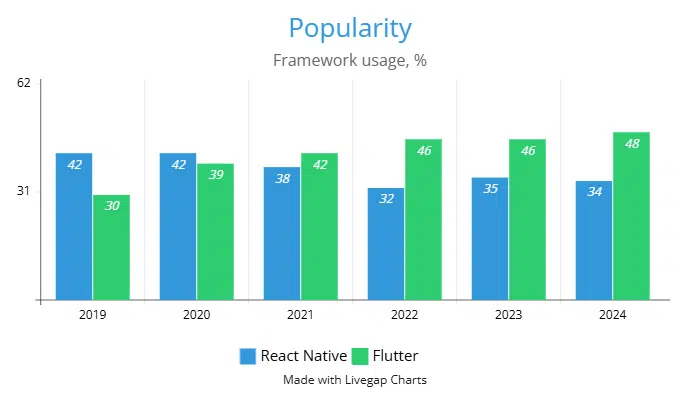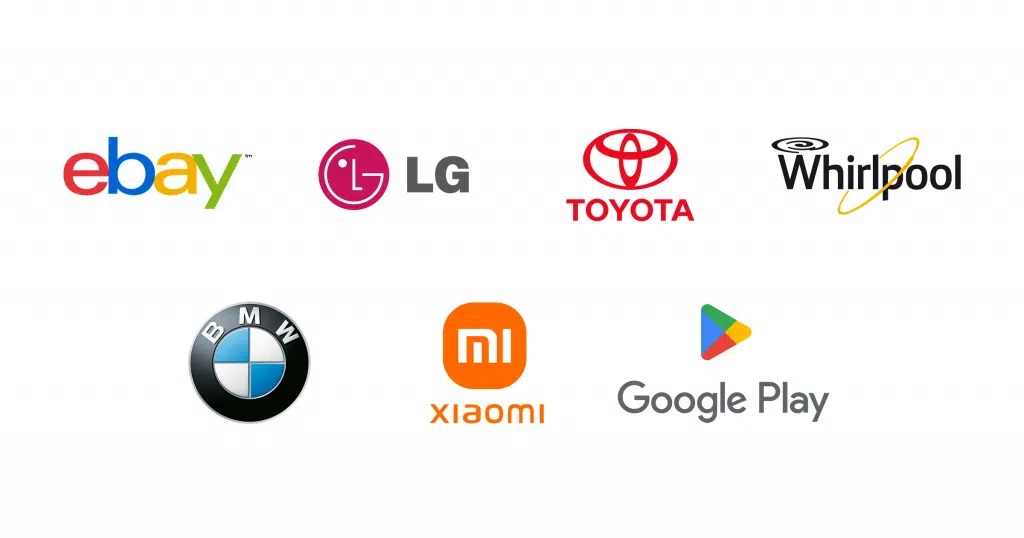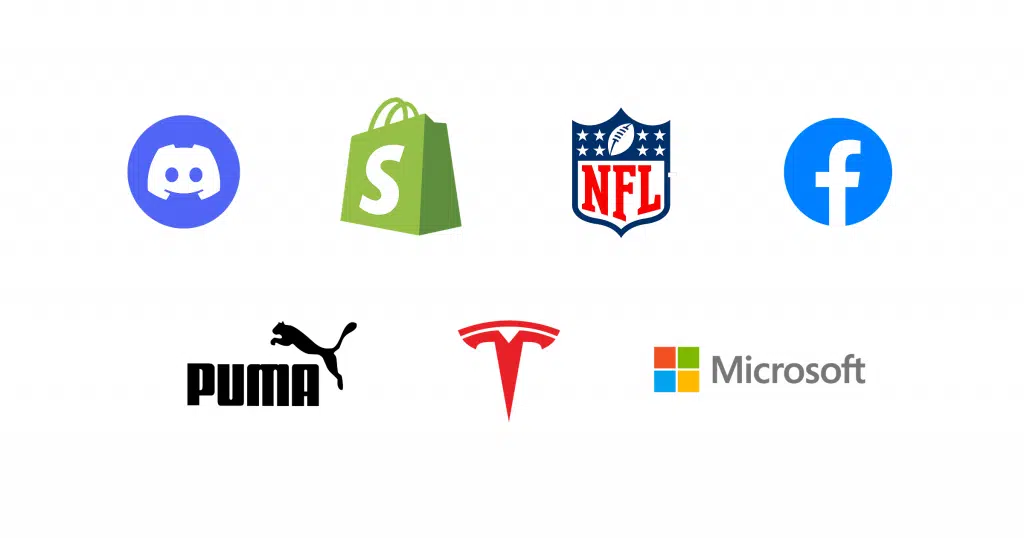Introduction: Why Flutter vs React Native Still Matters in 2025
You’d think by now the debate would be over.
Flutter vs React Native — we’ve been talking about it for years. They’ve both grown up, shipped updates, and run some massive apps. So why are we still comparing them?
Because in 2025, teams are still asking the same question:
“We’re building a cross-platform app. Should we go with Flutter or React Native?”
And the answer isn’t obvious — because both are good, but in different ways.
If you’ve already got a strong JavaScript team, React Native probably makes more sense. If you’re aiming for the most consistent design and smoothest animations across platforms, Flutter may be the better fit.
Let’s review what’s changed in 2025, and how Flutter and React Native really compare across:
- Performance (startup time, UI speed, memory use)
- Platforms (iOS, Android, Web, Desktop — and how well they actually work)
- Developer availability and hiring
- Dev experience, testing, and long-term maintainability
- Real-world examples (what companies use what — and why)
We hope this article will help you to pick the best tech for your specific case and build really good product.
Core Philosophy and Language
Before we look at charts or costs, it’s worth asking: how do Flutter and React Native actually approach app building — and what does that mean for your product?
They both let you build cross-platform apps, but they do it in very different ways.
React Native: Familiar and Native-Looking
React Native is built on JavaScript, the most widely used programming language in the world. For you, that means:
- It’s usually easier to find developers.
- If your existing team already works with web apps, they can adapt faster.
- The apps it produces often look and behave more like traditional iOS or Android apps, because they reuse a lot of the system’s built-in elements.
Business impact: Good fit if you want something that feels familiar to end-users and you need to get to market quickly, especially for simpler apps or MVPs.
Flutter: One System, Full Control
Flutter is based on Dart, which is less common but designed for fast, polished apps. The big difference is that Flutter doesn’t depend on the system’s built-in elements — it renders everything itself.
For you, that means:
- Your app looks the same everywhere — iOS, Android, web, or even desktop.
- Your design team has total freedom: custom animations, dashboards, or branded visuals are much easier to achieve.
- Performance is often smoother, even on older devices.
Business impact: A strong option if design consistency and user experience are top priorities, or if you’re planning to support multiple platforms beyond mobile.
At a Glance
| For your business | React Native | Flutter |
|---|---|---|
| Time to find developers | Easier (bigger talent pool) | Slightly harder, but growing fast |
| Look & feel | Feels “native” on each platform | Looks identical everywhere |
| Custom design flexibility | Limited by system rules | Full creative freedom |
| Performance | Good, but can vary | Consistently smooth |
Takeaway:
- If your goal is a quick launch and your team already knows JavaScript, React Native lowers the entry barrier.
- If you care more about polished design, consistency, and future scaling across multiple platforms, Flutter gives you more control.
Performance: Why Speed and Smoothness Still Matter
No matter how many features you pack into an app, users notice two things first: how fast it opens and how smooth it feels. In 2025, both Flutter and React Native can handle modern apps, but there are some clear differences.
Flutter: Smoother by Design
Because Flutter draws everything itself (instead of relying on each phone’s built-in UI parts), it can deliver a very consistent, smooth experience.
- Animations feel fluid, which is important for apps with dashboards, charts, or branded transitions.
- Apps often launch faster, because Flutter compiles directly to machine code.
- Even on mid-range or older devices, Flutter tends to keep things stable.
Business takeaway: If your app depends on visuals, charts, or custom design — think healthcare monitoring, delivery tracking, or creative tools — Flutter gives you an edge in user satisfaction.
React Native: Good, but Sometimes Variable
React Native has improved a lot thanks to updates in 2024–2025. It runs most apps without issues. But because it relies on a “bridge” between JavaScript and the phone’s system, there can be more variability.
- Simple apps run just fine.
- Complex UIs or heavy animations may feel slower, especially on older devices.
- Startup speed can be slightly longer compared to Flutter.
Business takeaway: If your app is straightforward — for example, lists, forms, or booking flows — React Native delivers acceptable performance. If you push into high design complexity, you may hit limitations faster.
Quick Comparison
| Area that matters to users | Flutter | React Native |
|---|---|---|
| App launch speed | Generally faster | Good, but can lag slightly |
| Smoothness of UI | Very consistent | Can vary by device |
| Handling of animations/dashboards | Strong | Adequate, but less reliable |
| Performance on older phones | More stable | May degrade faster |
According to latest statistical data, Flutter’s popularity has grown steadily over the past four years. For companies, this growth translates into practical benefits: a larger pool of experienced developers, a stronger knowledge base, and a wider set of open-source solutions that can be reused instead of building everything from scratch.

Platform Coverage: Mobile, Web, Desktop
Most businesses today don’t stop at just iOS and Android. You might want a web app for admins, a desktop tool for staff, or even a kiosk app for customers. The framework you choose will decide how easy (or painful) it is to expand.
React Native: Mobile First
React Native works best on iOS and Android.
There are community projects that add support for web and desktop, but they’re not the main focus. That means extra work and, in some cases, compromises in design or performance.
For companies that only care about mobile, this is fine. But if your roadmap includes multi-platform rollout, React Native can be limiting.
Flutter: Broader Reach Out of the Box
Flutter officially supports iOS, Android, Web, Windows, macOS, and Linux.
It uses the same codebase everywhere, so expanding to new platforms doesn’t mean starting from scratch.
This makes Flutter especially attractive for businesses that need both:
- a mobile app for end-users, and
- a web/desktop tool for staff or administrators.
Bottom Line
If your project is mobile-only, both frameworks deliver.
If you’re thinking bigger — web, desktop, or embedded apps — Flutter gives you more reach with less duplication of effort.
Developer Ecosystem & Hiring Trends
Technology is only half the story. The other half is people — can you actually find the developers to build and maintain your app?
React Native: Larger Talent Pool
Because it’s based on JavaScript, React Native benefits from one of the largest developer communities in the world.
- It’s usually easier and faster to hire React Native developers.
- Salaries can be more competitive, since the skill set overlaps with web development.
- A big ecosystem of libraries and tools already exists, though quality varies.
For companies that need to scale teams quickly, this can be a strong advantage.
Flutter: Growing Fast
According to Statista, Flutter’s popularity has steadily increased in the past four years. This growth has practical effects:
- More experienced Flutter developers are available now than ever before.
- A stronger knowledge base means faster problem-solving.
- A growing library of open-source solutions can save time and money.
While the talent pool is still smaller than React Native’s, the gap is closing quickly — and in some regions, Flutter developers are already easier to find.
What This Means for You
- If hiring speed is your top concern, React Native still has the edge.
- If you’re planning for the long term, Flutter’s momentum suggests it may become the safer bet in the coming years.
Development Experience & Testing
How fast your team can build, test, and improve an app directly affects time-to-market and long-term costs. Both Flutter and React Native offer tools to speed up the process, but in slightly different ways.
React Native: Familiar and Flexible
- Hot Reload lets developers see changes almost instantly while coding.
- Large JavaScript ecosystem means lots of third-party libraries, though quality can be inconsistent.
- Testing depends more on external tools and libraries, which can add complexity.
Flutter: Unified and Reliable
- Hot Reload also exists in Flutter, and is praised for being very stable.
- Built-in widget testing allows developers to test parts of the app’s interface without third-party tools.
- The framework offers a more consistent toolset out of the box, reducing the need to piece together solutions.
Cost of Development and Maintenance
When companies compare frameworks, cost is always on the table. It’s not just about the initial build — it’s also about maintenance, scaling, and updates over the next 3–5 years.
React Native: Lower Entry Cost
- If you already have a JavaScript/React team, React Native can be cheaper to start with.
- MVPs or simpler apps often reach the market faster, which reduces upfront costs.
- However, as the app grows in complexity, you may need more workarounds and third-party tools, which can increase costs over time.
Flutter: Predictable Long-Term Costs
- Even if your team doesn’t know Dart, onboarding is usually quick — and the single codebase covers mobile, web, and desktop.
- Built-in tooling and consistent performance reduce the risk of major rewrites later.
- Maintenance tends to be easier because Flutter apps are less affected by platform quirks after OS updates.
Business Impact
- React Native may look cheaper at the start, especially for MVPs or when you already have in-house JavaScript skills.
- Flutter often wins on total cost of ownership: fewer bugs, smoother scaling, and no need to constantly patch platform differences.
Use cases
Both Flutter and React Native are trusted by some of the world’s biggest companies. That alone shows there’s no “wrong” choice — each framework has proven itself at scale.
Flutter

React

When to Choose Flutter vs React Native
No framework is “better” in every situation. The right choice depends on your product goals, your timeline, and your team.
Quick Comparison
| If your goal is… | Flutter | React Native |
|---|---|---|
| Smooth animations and advanced UI | ✅ Best fit | ⚠️ Possible, but less reliable |
| Consistent look across platforms | ✅ Strong | ⚠️ Depends on platform |
| Speed to first launch (MVP) | ⚠️ Slightly slower | ✅ Faster |
| Using existing web/React team | ⚠️ Steeper learning curve | ✅ Immediate |
| Long-term scalability | ✅ More predictable | ⚠️ More patchwork needed |
| Running on web + desktop too | ✅ Official support | ⚠️ Community-based |
Summary
In 2025, both Flutter and React Native are capable of powering serious products — from healthcare platforms to e-commerce and logistics apps. The decision between them isn’t about which framework is “better” overall, but about which one aligns with your business priorities.
- React Native is often the faster and cheaper way to launch an MVP, especially if your team already works with JavaScript. It’s well-suited for simpler applications, prototypes, or products where time-to-market is the main driver.
- Flutter is stronger for complex, design-driven, or multi-platform projects. Its consistent UI, smoother performance, and official support for mobile, web, and desktop make it more predictable in the long term.
For most companies, the framework you choose will shape not only how quickly you can launch, but also how expensive the app is to maintain and scale in the coming years. shape not only how quickly you can launch, but also how expensive the app is to maintain and scale in the coming years.




